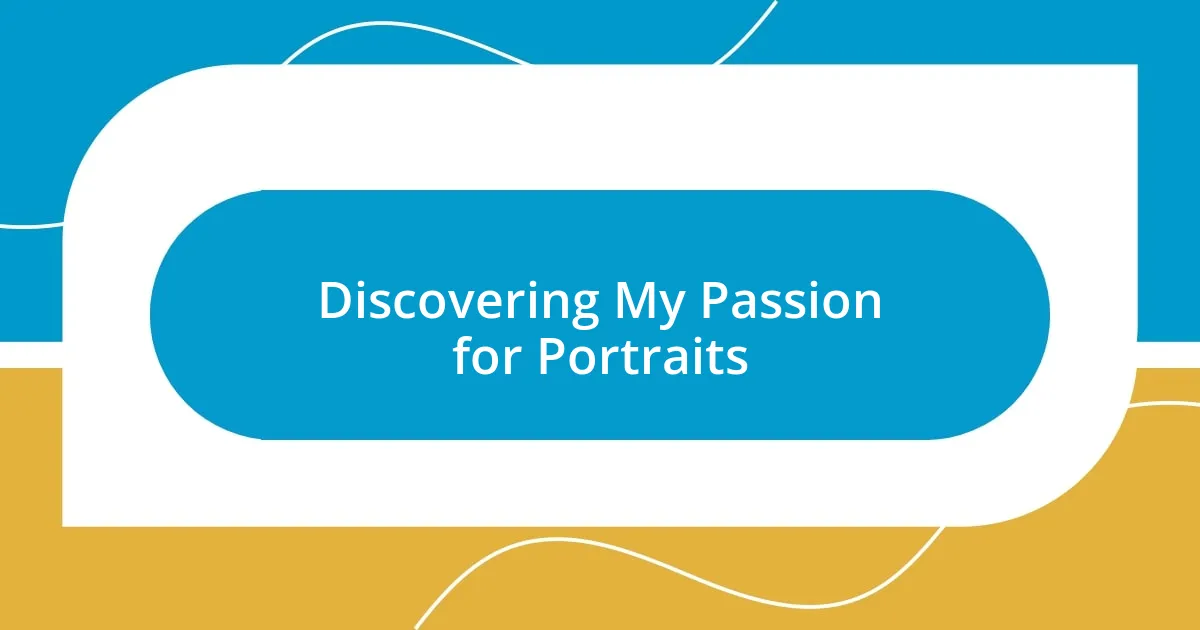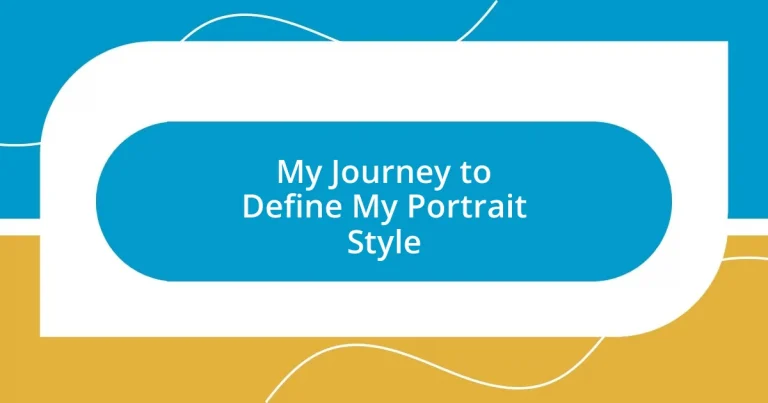Key takeaways:
- Initial passion for portrait photography sparked by capturing a friend’s laughter, highlighting the emotional depth in images.
- Exploration of various portrait styles, including environmental, candid, and abstract, has expanded creative expression and storytelling.
- Experimentation with techniques such as oil painting and digital editing transformed photographs into vibrant art pieces, enhancing personal interpretation.
- Seeking inspiration from other artists and embracing vulnerability through sharing work has refined artistic voice and encouraged meaningful connections.

Discovering My Passion for Portraits
I stumbled upon my passion for portraits almost by accident. One afternoon, I picked up my camera and decided to photograph a friend. As I captured her laughter, I felt an unexpected thrill; it was as if I was freezing a moment in time that radiated with her essence.
I still remember the first portrait that truly moved me. It was a black-and-white shot of my grandmother, her wrinkles narrating stories of resilience. Looking at that image, I realized how much depth and emotion could reside in a single frame. Isn’t it fascinating how a portrait can bring out the untold stories of someone’s life?
Each time I photograph a face, I find myself asking, “What makes this person unique?” It’s that curiosity that fuels my creativity. I can recall a time when I spent hours simply chatting with my subject before even raising my camera. Nothing compares to the connection I feel when I capture their true self, and that’s what keeps me coming back to portrait photography.

Exploring Different Portrait Styles
Exploring various portrait styles has truly been a transformative journey for me. Each style offers a unique lens to view personality and emotion. For instance, I experimented with environmental portraits, where the subject’s surroundings become an integral part of the story. One time, I photographed a local artist in her vibrant studio, surrounded by her eclectic works. The paints and brushes didn’t just frame her; they emitted her passion for creativity. That experience made me realize how context can elevate a simple portrait into a narrative.
Here’s a glimpse into the different portrait styles I’ve explored:
- Traditional Portraits: Formal poses against plain backgrounds focusing on the subject.
- Environmental Portraits: Capturing subjects in their natural settings, highlighting their stories.
- Candid Portraits: Snapping moments of genuine emotions, often unaware of the camera.
- Conceptual Portraits: Combining elements of fantasy or symbolism, creating a deeper meaning.
- Abstract Portraits: Using light, shadow, and colors to focus more on the subject’s essence rather than their physical features.
Each of these styles stretches my creativity in new directions, pushing me to discover the rich tapestry of human expression.

Experimenting with Techniques and Mediums
Experimenting with different techniques and mediums has opened a world of possibilities for my portrait photography. I vividly recall my first encounter with oil paints. I decided to create a mixed-media portrait of a friend after capturing her expression in a photograph. The feel of the brush against the canvas as I blended colors brought a new depth to the image. Using paint not only added vividness to her features but also allowed me to interpret her personality in a whole new light. Isn’t it amazing how a simple addition can transform a mere photograph into a piece of art?
I’ve also embraced digital editing as an experimental medium. The first time I used Photoshop to manipulate an image, I felt both nervous and excited. The ability to enhance colors, adjust lighting, and even alter backgrounds gave me creative liberty I hadn’t known before. I still remember modifying an ordinary portrait of a friend, infusing it with dreamlike qualities. It felt like I was crafting a narrative beyond the visible, enhancing not just the image but the stories intertwined with it.
Finally, I started to play with unconventional tools, like using prisms and mirrors to create unique reflections. This technique began when I was attempting to capture the essence of my sister, who is full of life and energy. The way the light bent and fractured was breathtaking, resulting in a series of portraits that felt alive and vibrant. Each experiment has taught me something valuable about not just the medium but about the subjects I’ve worked with. Have you ever found inspiration in unexpected tools? It’s sometimes the simple acts of curiosity that lead to the masterpieces we never imagined.
| Technique/Medium | Personal Experience |
|---|---|
| Oil Painting | Created a mixed-media portrait that added depth to a photograph of a friend. |
| Digital Editing | Transformed an ordinary photo with dreamlike qualities using Photoshop for my friend’s portrait. |
| Prisms and Mirrors | Captured vibrant reflections of my sister, creating a series of lively portraits. |

Seeking Inspiration from Other Artists
Seeking inspiration from other artists has been a pivotal part of my journey. I remember attending a local art exhibit where I stumbled upon the work of a portrait artist whose use of color was breathtaking. The vibrancy he infused into his subjects made me ask, “How can I capture that same energy?” That moment helped me realize that every artist, no matter their medium, speaks a unique language through their work.
One afternoon, I reached out to an illustrator whose style I admired online. We chatted over coffee, and I was struck by her approach to storytelling through character design. Listening to her passion for blending realism with imagination opened my eyes to new possibilities. It made me wonder: what if I combined elements of fantasy in my portraits? This exchange sparked a whole new direction in my artistic exploration.
Inspiration also comes from smaller moments, like flipping through art books or scrolling through artists’ social media profiles. Each piece resonates differently, and I often find myself pausing to reflect on why a particular image speaks to me. I now frequently ask myself, “What emotions does this stir in me?” Sometimes, adopting the essence of another artist’s approach can lead to breakthroughs in my own style, encouraging me to forge a portrait style that is genuinely mine.

Refining My Unique Artistic Voice
Refining my unique artistic voice has been a journey of introspection. One of the most impactful moments came during a photography workshop where I was challenged to define my style in just a few words. I remember feeling overwhelmed at first, but as I thought about my work, words like “emotion,” “story,” and “connection” began to surface. This clarity was illuminating—it made me realize that my artistic voice lies in my ability to evoke feelings through my portraits.
With each photograph I take, I strive to capture not just the likeness of my subjects but their essence. There was a time when I photographed an elderly man in the park, and instead of focusing solely on his smiling face, I asked him to share a memory. As he spoke, I captured not only his image but the warmth of his recollections—an unguarded moment that transformed a simple portrait into a vibrant narrative. Don’t you think that weaving stories into images adds layers of meaning?
Part of refining my voice has also involved embracing vulnerability. I’ve begun to share my unfinished works and rough drafts online, inviting feedback from fellow artists and friends. This process can be daunting, as it exposes my creative wounds, but it’s been enlightening too. The conversations that follow often reveal aspects of my art that I hadn’t considered before, prompting me to evolve. I’ve realized that every piece, every interaction, and every critique brings me one step closer to creating a body of work that truly represents who I am as an artist. How has sharing your work influenced your artistic journey? For me, it’s become a transformative experience.












